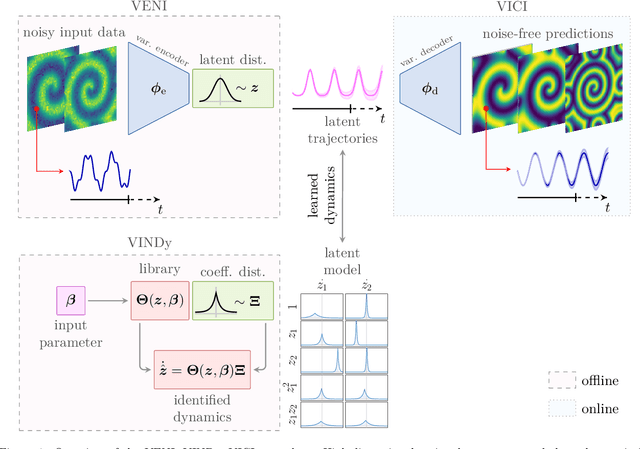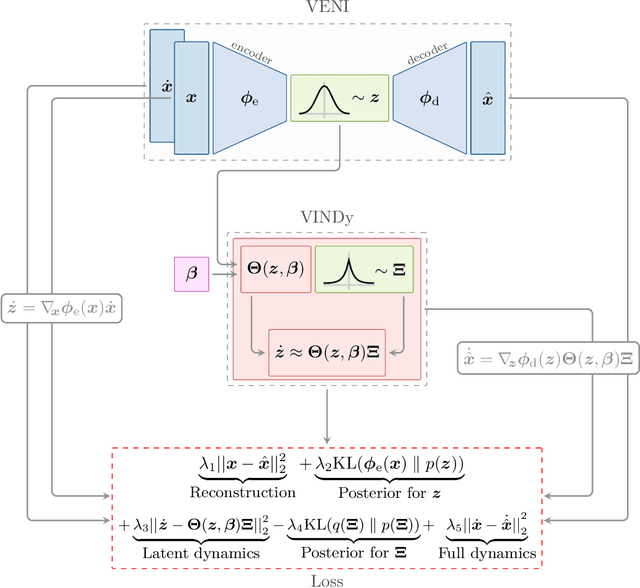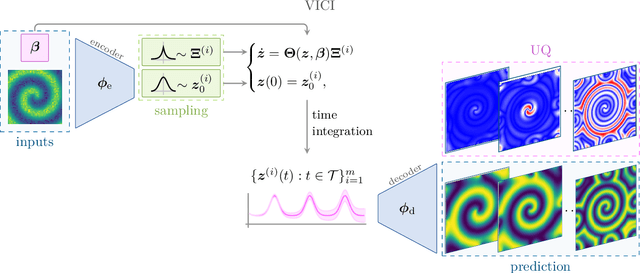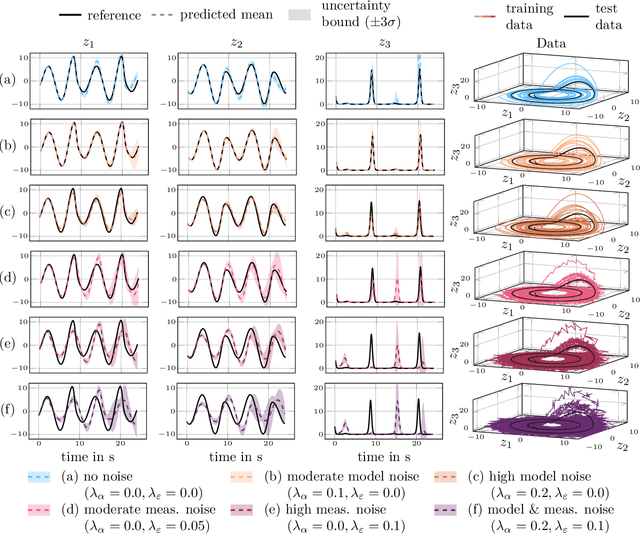J. Nathan Kutz
Department of Applied Mathematics, University of Washington
From Models To Experiments: Shallow Recurrent Decoder Networks on the DYNASTY Experimental Facility
Mar 11, 2025Abstract:The Shallow Recurrent Decoder networks are a novel paradigm recently introduced for state estimation, combining sparse observations with high-dimensional model data. This architecture features important advantages compared to standard data-driven methods including: the ability to use only three sensors (even randomly selected) for reconstructing the entire dynamics of a physical system; the ability to train on compressed data spanned by a reduced basis; the ability to measure a single field variable (easy to measure) and reconstruct coupled spatio-temporal fields that are not observable and minimal hyper-parameter tuning. This approach has been verified on different test cases within different fields including nuclear reactors, even though an application to a real experimental facility, adopting the employment of in-situ observed quantities, is missing. This work aims to fill this gap by applying the Shallow Recurrent Decoder architecture to the DYNASTY facility, built at Politecnico di Milano, which studies the natural circulation established by internally heated fluids for Generation IV applications, especially in the case of Circulating Fuel reactors. The RELAP5 code is used to generate the high-fidelity data, and temperature measurements extracted by the facility are used as input for the state estimation. The results of this work will provide a validation of the Shallow Recurrent Decoder architecture to engineering systems, showing the capabilities of this approach to provide and accurate state estimation.
Towards Efficient Parametric State Estimation in Circulating Fuel Reactors with Shallow Recurrent Decoder Networks
Mar 11, 2025Abstract:The recent developments in data-driven methods have paved the way to new methodologies to provide accurate state reconstruction of engineering systems; nuclear reactors represent particularly challenging applications for this task due to the complexity of the strongly coupled physics involved and the extremely harsh and hostile environments, especially for new technologies such as Generation-IV reactors. Data-driven techniques can combine different sources of information, including computational proxy models and local noisy measurements on the system, to robustly estimate the state. This work leverages the novel Shallow Recurrent Decoder architecture to infer the entire state vector (including neutron fluxes, precursors concentrations, temperature, pressure and velocity) of a reactor from three out-of-core time-series neutron flux measurements alone. In particular, this work extends the standard architecture to treat parametric time-series data, ensuring the possibility of investigating different accidental scenarios and showing the capabilities of this approach to provide an accurate state estimation in various operating conditions. This paper considers as a test case the Molten Salt Fast Reactor (MSFR), a Generation-IV reactor concept, characterised by strong coupling between the neutronics and the thermal hydraulics due to the liquid nature of the fuel. The promising results of this work are further strengthened by the possibility of quantifying the uncertainty associated with the state estimation, due to the considerably low training cost. The accurate reconstruction of every characteristic field in real-time makes this approach suitable for monitoring and control purposes in the framework of a reactor digital twin.
Coarse graining and reduced order models for plume ejection dynamics
Mar 06, 2025Abstract:Monitoring the atmospheric dispersion of pollutants is increasingly critical for environmental impact assessments. High-fidelity computational models are often employed to simulate plume dynamics, guiding decision-making and prioritizing resource deployment. However, such models can be prohibitively expensive to simulate, as they require resolving turbulent flows at fine spatial and temporal resolutions. Moreover, there are at least two distinct dynamical regimes of interest in the plume: (i) the initial ejection of the plume where turbulent mixing is generated by the shear-driven Kelvin-Helmholtz instability, and (ii) the ensuing turbulent diffusion and advection which is often modeled by the Gaussian plume model. We address the challenge of modeling the initial plume generation. Specifically, we propose a data-driven framework that identifies a reduced-order analytical model for plume dynamics -- directly from video data. We extract a time series of plume center and edge points from video snapshots and evaluate different regressions based to their extrapolation performance to generate a time series of coefficients that characterize the plume's overall direction and spread. We regress to a sinusoidal model inspired by the Kelvin-Helmholtz instability for the edge points in order to identify the plume's dispersion and vorticity. Overall, this reduced-order modeling framework provides a data-driven and lightweight approach to capture the dominant features of the initial nonlinear point-source plume dynamics, agnostic to plume type and starting only from video. The resulting model is a pre-cursor to standard models such as the Gaussian plume model and has the potential to enable rapid assessment and evaluation of critical environmental hazards, such as methane leaks, chemical spills, and pollutant dispersal from smokestacks.
Inverse Design with Dynamic Mode Decomposition
Feb 13, 2025Abstract:We introduce a computationally efficient method for the automation of inverse design in science and engineering. Based on simple least-square regression, the underlying dynamic mode decomposition algorithm can be used to construct a low-rank subspace spanning multiple experiments in parameter space. The proposed inverse design dynamic mode composition (ID-DMD) algorithm leverages the computed low-dimensional subspace to enable fast digital design and optimization on laptop-level computing, including the potential to prescribe the dynamics themselves. Moreover, the method is robust to noise, physically interpretable, and can provide uncertainty quantification metrics. The architecture can also efficiently scale to large-scale design problems using randomized algorithms in the ID-DMD. The simplicity of the method and its implementation are highly attractive in practice, and the ID-DMD has been demonstrated to be an order of magnitude more accurate than competing methods while simultaneously being 3-5 orders faster on challenging engineering design problems ranging from structural vibrations to fluid dynamics. Due to its speed, robustness, interpretability, and ease-of-use, ID-DMD in comparison with other leading machine learning methods represents a significant advancement in data-driven methods for inverse design and optimization, promising a paradigm shift in how to approach inverse design in practice.
Reservoir computing for system identification and predictive control with limited data
Oct 23, 2024Abstract:Model predictive control (MPC) is an industry standard control technique that iteratively solves an open-loop optimization problem to guide a system towards a desired state or trajectory. Consequently, an accurate forward model of system dynamics is critical for the efficacy of MPC and much recent work has been aimed at the use of neural networks to act as data-driven surrogate models to enable MPC. Perhaps the most common network architecture applied to this task is the recurrent neural network (RNN) due to its natural interpretation as a dynamical system. In this work, we assess the ability of RNN variants to both learn the dynamics of benchmark control systems and serve as surrogate models for MPC. We find that echo state networks (ESNs) have a variety of benefits over competing architectures, namely reductions in computational complexity, longer valid prediction times, and reductions in cost of the MPC objective function.
Towards a Reliable Offline Personal AI Assistant for Long Duration Spaceflight
Oct 21, 2024Abstract:As humanity prepares for new missions to the Moon and Mars, astronauts will need to operate with greater autonomy, given the communication delays that make real-time support from Earth difficult. For instance, messages between Mars and Earth can take up to 24 minutes, making quick responses impossible. This limitation poses a challenge for astronauts who must rely on in-situ tools to access the large volume of data from spacecraft sensors, rovers, and satellites, data that is often fragmented and difficult to use. To bridge this gap, systems like the Mars Exploration Telemetry-Driven Information System (METIS) are being developed. METIS is an AI assistant designed to handle routine tasks, monitor spacecraft systems, and detect anomalies, all while reducing the reliance on mission control. Current Generative Pretrained Transformer (GPT) Models, while powerful, struggle in safety-critical environments. They can generate plausible but incorrect responses, a phenomenon known as "hallucination," which could endanger astronauts. To overcome these limitations, this paper proposes enhancing systems like METIS by integrating GPTs, Retrieval-Augmented Generation (RAG), Knowledge Graphs (KGs), and Augmented Reality (AR). The idea is to allow astronauts to interact with their data more intuitively, using natural language queries and visualizing real-time information through AR. KGs will be used to easily access live telemetry and multimodal data, ensuring that astronauts have the right information at the right time. By combining AI, KGs, and AR, this new system will empower astronauts to work more autonomously, safely, and efficiently during future space missions.
Deep Generative Modeling for Identification of Noisy, Non-Stationary Dynamical Systems
Oct 02, 2024



Abstract:A significant challenge in many fields of science and engineering is making sense of time-dependent measurement data by recovering governing equations in the form of differential equations. We focus on finding parsimonious ordinary differential equation (ODE) models for nonlinear, noisy, and non-autonomous dynamical systems and propose a machine learning method for data-driven system identification. While many methods tackle noisy and limited data, non-stationarity - where differential equation parameters change over time - has received less attention. Our method, dynamic SINDy, combines variational inference with SINDy (sparse identification of nonlinear dynamics) to model time-varying coefficients of sparse ODEs. This framework allows for uncertainty quantification of ODE coefficients, expanding on previous methods for autonomous systems. These coefficients are then interpreted as latent variables and added to the system to obtain an autonomous dynamical model. We validate our approach using synthetic data, including nonlinear oscillators and the Lorenz system, and apply it to neuronal activity data from C. elegans. Dynamic SINDy uncovers a global nonlinear model, showing it can handle real, noisy, and chaotic datasets. We aim to apply our method to a variety of problems, specifically dynamic systems with complex time-dependent parameters.
AI Assistants for Spaceflight Procedures: Combining Generative Pre-Trained Transformer and Retrieval-Augmented Generation on Knowledge Graphs With Augmented Reality Cues
Sep 21, 2024Abstract:This paper describes the capabilities and potential of the intelligent personal assistant (IPA) CORE (Checklist Organizer for Research and Exploration), designed to support astronauts during procedures onboard the International Space Station (ISS), the Lunar Gateway station, and beyond. We reflect on the importance of a reliable and flexible assistant capable of offline operation and highlight the usefulness of audiovisual interaction using augmented reality elements to intuitively display checklist information. We argue that current approaches to the design of IPAs in space operations fall short of meeting these criteria. Therefore, we propose CORE as an assistant that combines Knowledge Graphs (KGs), Retrieval-Augmented Generation (RAG) for a Generative Pre-Trained Transformer (GPT), and Augmented Reality (AR) elements to ensure an intuitive understanding of procedure steps, reliability, offline availability, and flexibility in terms of response style and procedure updates.
VENI, VINDy, VICI: a variational reduced-order modeling framework with uncertainty quantification
May 31, 2024



Abstract:The simulation of many complex phenomena in engineering and science requires solving expensive, high-dimensional systems of partial differential equations (PDEs). To circumvent this, reduced-order models (ROMs) have been developed to speed up computations. However, when governing equations are unknown or partially known, typically ROMs lack interpretability and reliability of the predicted solutions. In this work we present a data-driven, non-intrusive framework for building ROMs where the latent variables and dynamics are identified in an interpretable manner and uncertainty is quantified. Starting from a limited amount of high-dimensional, noisy data the proposed framework constructs an efficient ROM by leveraging variational autoencoders for dimensionality reduction along with a newly introduced, variational version of sparse identification of nonlinear dynamics (SINDy), which we refer to as Variational Identification of Nonlinear Dynamics (VINDy). In detail, the method consists of Variational Encoding of Noisy Inputs (VENI) to identify the distribution of reduced coordinates. Simultaneously, we learn the distribution of the coefficients of a pre-determined set of candidate functions by VINDy. Once trained offline, the identified model can be queried for new parameter instances and new initial conditions to compute the corresponding full-time solutions. The probabilistic setup enables uncertainty quantification as the online testing consists of Variational Inference naturally providing Certainty Intervals (VICI). In this work we showcase the effectiveness of the newly proposed VINDy method in identifying interpretable and accurate dynamical system for the R\"ossler system with different noise intensities and sources. Then the performance of the overall method - named VENI, VINDy, VICI - is tested on PDE benchmarks including structural mechanics and fluid dynamics.
Shallow Recurrent Decoder for Reduced Order Modeling of Plasma Dynamics
May 20, 2024



Abstract:Reduced order models are becoming increasingly important for rendering complex and multiscale spatio-temporal dynamics computationally tractable. The computational efficiency of such surrogate models is especially important for design, exhaustive exploration and physical understanding. Plasma simulations, in particular those applied to the study of ${\bf E}\times {\bf B}$ plasma discharges and technologies, such as Hall thrusters, require substantial computational resources in order to resolve the multidimentional dynamics that span across wide spatial and temporal scales. Although high-fidelity computational tools are available to simulate such systems over limited conditions and in highly simplified geometries, simulations of full-size systems and/or extensive parametric studies over many geometric configurations and under different physical conditions are computationally intractable with conventional numerical tools. Thus, scientific studies and industrially oriented modeling of plasma systems, including the important ${\bf E}\times {\bf B}$ technologies, stand to significantly benefit from reduced order modeling algorithms. We develop a model reduction scheme based upon a {\em Shallow REcurrent Decoder} (SHRED) architecture. The scheme uses a neural network for encoding limited sensor measurements in time (sequence-to-sequence encoding) to full state-space reconstructions via a decoder network. Based upon the theory of separation of variables, the SHRED architecture is capable of (i) reconstructing full spatio-temporal fields with as little as three point sensors, even the fields that are not measured with sensor feeds but that are in dynamic coupling with the measured field, and (ii) forecasting the future state of the system using neural network roll-outs from the trained time encoding model.
 Add to Chrome
Add to Chrome Add to Firefox
Add to Firefox Add to Edge
Add to Edge